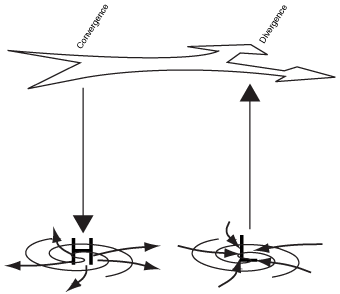Weather: High Points and Low
High Points and Low
Here we are talking about pressure, and the subject of vertical motions appears once again. Well, why not? Take a look at the next figure to see what's going on.
Let's think about it. If rising air causes rain, what causes the rising motion? A force in the atmosphere at high levels that takes the air out and away. The atmosphere is really a three-dimensional layer cake, and motions aloft don't always resemble what's occurring at ground level. An outflow of air in the upper atmosphere is one of the most common mechanisms for drawing the atmosphere upward and setting off those vertical motions that lead to rain.

Origins of high and low pressure.
That high-level divergence of air is something weather forecasters are always looking for. Heating can cause the atmosphere to rise, too, and converging currents near the ground can deliver lift as well. Also as air runs into a mountain, it lifts. All of these bring about precipitation, but whenever the atmosphere is lifted away from the earth's surface, and that air is drawn away at high levels, the pressure in the atmospheric column will be lowered. Therefore, low pressure is always associated with stormy weather.
On the other hand, if the atmosphere is forced to sink toward the earth's surface, the weight of the air will be greater and the pressure will rise. The skies might have been stormy, but as the barometer begins to rise the skies will clear. Therefore, high pressure is associated with a sunny day.
Weather-Speak
Convergence in the atmosphere occurs when air comes together at a particular location. That would take place if opposing winds meet over that point. Convergence would also occur if more air enters a region than departs. Divergence describes the opposite process where more air leaves than arrives.
Of course, there are always exceptions. I can remember my share of high-pressure systems when rain was falling. That occurred when the area of high pressure was really shallow and air was actually rising above it. But overall rising air goes along with lowering pressure, and sunny sinking motions happen with high-pressure areas. Those pressure areas are really defined by the vertical motions.

Excerpted from The Complete Idiot's Guide to Weather © 2002 by Mel Goldstein, Ph.D.. All rights reserved including the right of reproduction in whole or in part in any form. Used by arrangement with Alpha Books, a member of Penguin Group (USA) Inc.







